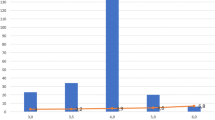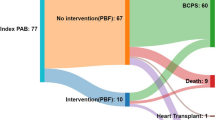Abstract
Objectives
The aim of this study was to analyze the risk factors for acute events after systemic-to-pulmonary shunt (SPS) and to investigate the effectiveness of pulmonary blood flow regulation with a metal clip.
Methods
The case histories of 116 patients (78 biventricular [BV] and 38 single ventricle [SV] physiology) who underwent SPS between 2010 and 2021 were retrospectively reviewed. Our strategy was to delay SPS until 1 month of age; pulmonary blood flow (PBF) regulation by partial clipping of the graft, if needed. Cases of aortic cross-clamping were excluded from this study.
Results
CPB was used in 49 (42%) patients: the median age at SPS was 1 month (2 days to 16 years), and the sternotomy approach in 65. Discharge survival was 98.3% (114/116); hospital death occurred in 1.7% due to coronary ischemia. Inter-stage mortality occurred in 1.7% (shunt thrombosis, 1; pneumonia, 1). Pre-discharge acute events occurred in 7 patients (6.0%): thrombosis 3, pulmonary over-circulation 2, and coronary ischemia 2. Multiple logistic regression analysis revealed that pulmonary atresia with intact ventricular septum (PA/IVS) (p = 0.0253) was an independent risk factor for acute events. Partial clipping of the graft was performed in 24 patients (pulmonary atresia 15) and clip removal was performed by catheter intervention in 9 patients; no coronary ischemic events and graft injury occurred in these patients.
Conclusion
Surgical outcomes after SPS were acceptable and metal clip regulation of pulmonary blood flow appears to be safe and effective. PA/IVS was still a significant risk factor for acute events.


Similar content being viewed by others
Data availability
All patients were selected by the search term BTS or CS in the database of all patients with consultancy in Niigata University Hospital. Patient’s names were anonymized and each were given an unique code, which cannot be traced back. All data were collected in an encrypted excel file, only accessible for the authors. The data underlying this article cannot be shared publicly due to privacy of the patients and will only be shared on reasonable request to the corresponding author.
References
Blalock A, Taussig HB. Landmark article May 19, 1945: the surgical treatment of malformations of the heart in which there is pulmonary stenosis or pulmonary atresia. JAMA. 1984;251:2123–38.
de Leval MR, McKay R, Jones M, Stark J, Macartney FJ. Modified Blalock-Taussig shunt. Use of subclavian artery orifice as flow regulator in prosthetic systemic-pulmonary artery shunts. J Thorac Cardiovasc Surg. 1981;81(1):112–9.
Dirks V, Prêtre R, Knirsch W, Valsangiacomo Buechel ER, Seifert B, Schweiger M, Hübler M, Dave H. Modified Blalock Taussig shunt: a not-so-simple palliative procedure. Eur J Cardiothorac Surg. 2013;44(6):1096–102.
Dorobantu DM, Pandey R, Sharabiani MT, Mahani AS, Angelini GD, Martin RP, Stoica SC. Indications and results of systemic to pulmonary shunts: results from a national database. Eur J Cardiothorac Surg. 2016;49(6):1553–63.
Alsoufi B, Gillespie S, Mori M, Clabby M, Kanter K, Kogon B. Factors affecting death and progression towards next stage following modified Blalock-Taussig shunt in neonates. Eur J Cardiothorac Surg. 2016;50(1):169–77.
Santro T, d’Udekem Y, Zannino D, Hobbes B, Konstantinov IE, Brizard C, Brink J. Determinants of acute events leading to mortality after shunt procedure in univentricular palliation. J Thorac Cardiovasc Surg. 2019;158(4):1144-1153.e6.
Alsoufi B, McCracken C, Schlosser B, Sachdeva R, Well A, Kogon B, Border W, Kanter K. Outcomes of multistage palliation of infants with functional single ventricle and heterotaxy syndrome. J Thorac Cardiovasc Surg. 2016;151(5):1369-77.e2.
Singh SP, Chauhan S, Choudhury M, Malik V, Talwar S, Hote MP, Devagourou V. Modified Blalock Taussig shunt: comparison between neonates, infants and older children. Ann Card Anaesth. 2014;17(3):191–7.
Kuduvalli M, McLaughlin KE, Trivedi DB, Pozzi M. Norwood-type operation with adjustable systemic—pulmonary shunt using hemostatic clip. Ann Thorac Surg. 2001;72:634–5.
Napoleone C, Oppido G, Angeli E, Gargiulo G. Adjustable aorto-pulmonary shunt to prevent temporary pulmonary over-circulation. Pace Eur J Cardiothorac Surg. 2006;29(2):253–4.
Chittithavorn V, Duangpakdee P, Rergkliang C, Pruekprasert N. Risk factors for in-hospital shunt thrombosis and mortality in patients weighing less than 3 kg with functionally univentricular heart undergoing a modified Blalock-Taussig shunt. Interact Cardiovasc Thorac Surg. 2017;25(3):407–13.
Myers JW, Ghanayem NS, Cao Y, Simpson P, Trapp K, Mitchell ME, Tweddell JS, Woods RK. Outcomes of systemic to pulmonary artery shunts in patients weighing less than 3 kg: analysis of shunt type, size, and surgical approach. J Thorac Cardiovasc Surg. 2014;147(2):672–7.
Mohammadi S, Benhameid O, Campbell A, Potts J, Joza J, Al-Habib H, Sett S, Le Blanc J. Could we still improve early and interim outcome after prosthetic systemic-pulmonary shunt? A risk factors analysis. Eur J Cardiothorac Surg. 2008;34(3):545–9.
van Vonderen JJ, Roest AA, Siew ML, Walther FJ, Hooper SB, te Pas AB. Measuring physiological changes during the transition to life after birth. Neonatology. 2014;105(3):230–42.
Miller OI, Tang SF, Keech A, Pigott NB, Beller E, Celermajer DS. Inhaled nitric oxide and prevention of pulmonary hypertension after congenital heart surgery: a randomised double-blind study. Lancet. 2000;356(9240):1464–9.
Motohashi Y, Shimada R, Sasaki T, Katsumata T, Dan K, Tsutsui Y, Emot S. Development of a simple device enabling percutaneous flow regulation for a small vascular graft for a Blalock–Taussig shunt capable of flow regulation: complete translation of an original article originally published in Pediatric Cardiology and Cardiac Surgery (154–159, 2016: vol. 32). Gen Thorac Cardiovasc Surg. 2018;66(3):145–9.
Mohiuddin MW, Resig PP, Sexton KW, Douglas WI. Two-day control of pulmonary blood flow with an adjustable systemic-pulmonary artery shunt. ASAIO J. 2011;57(3):225–30.
Chikada M, Sekiguchi A, Oho S, Miyamoto T, Ishida R, Takayama H, Ishizawa A. Dilatable banding of a Blalock-Taussig shunt. Ann Thorac Surg. 2002;74:253–5.
Talwar S, Kumar MV, Muthukkumaran S, Airan B. Is sternotomy superior to thoracotomy for modified Blalock-Taussig shunt? Interact Cardiovasc Thorac Surg. 2014;18(3):371–5.
Brink J, MacIver R, Lee MG, Konstantinov IE, Cheung M, Brizard CP, d’Udekem Y. Neonatal pulmonary artery reconstruction during shunting to treat and prevent juxtaductal coarctation. Ann Thorac Surg. 2015;99(2):641–7.
Guleserian KJ, Armsby LB, Thiagarajan RR, del Nido PJ, Mayer JE. Natural history of pulmonary atresia with intact ventricular septum and right-ventricle-dependent coronary circulation managed by the single-ventricle approach. Ann Thorac Surg. 2006;81(6):2250–7.
Ashburn DA, Blackstone EH, Wells WJ et al. Congenital Heart Surgeons Study members. Determinants of mortality and type of repair in neonates with pulmonary atresia and intact ventricular septum. J Thorac Cardiovasc Surg. 2004;127(4): 1000–7.
Author information
Authors and Affiliations
Corresponding author
Ethics declarations
Conflict of interest
The authors declare that they do not have any conflict of interests.
Additional information
Publisher's Note
Springer Nature remains neutral with regard to jurisdictional claims in published maps and institutional affiliations.
Rights and permissions
Springer Nature or its licensor (e.g. a society or other partner) holds exclusive rights to this article under a publishing agreement with the author(s) or other rightsholder(s); author self-archiving of the accepted manuscript version of this article is solely governed by the terms of such publishing agreement and applicable law.
About this article
Cite this article
Shiraishi, S., Watanabe, M., Sugimoto, A. et al. Surgical outcomes of the systemic-to-pulmonary artery shunt: risk factors of post-operative acute events and effectiveness of regulation of pulmonary blood flow with metal clips. Gen Thorac Cardiovasc Surg (2024). https://doi.org/10.1007/s11748-024-02028-8
Received:
Accepted:
Published:
DOI: https://doi.org/10.1007/s11748-024-02028-8




